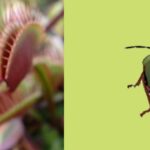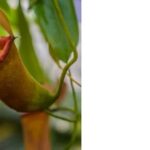As an Amazon Associate, this site earns commissions from qualifying purchases. For more details, click here.
Stink bugs can be a real nuisance especially in large numbers, so can a pitcher plant help you get rid of them? These are carnivorous plants that eat ants, gnats, butterflies and other insects. Can you include stink bugs in the list of live prey they eat? You are in the right place as this article answers those questions.
Pitcher plants eat stink bugs to boost their nutrient intake. Because these nutrients are not in the soil, carnivorous plants developed traps to lure stink bugs and extract these elements.
Why Pitcher Plants Eat Stink Bugs
A common misconception is that pitcher plants have to eat insects like stink bugs to stay alive. Actually, nepenthes and sarracenia can survive on only water and sunlight. Those two elements enable plants to produce glucose which serves as plant food.
Pitcher plants eat stink bugs because they are rich in nutrients. Calcium, potassium and in particular nitrogen help plants grow and develop resistance to disease. Because carnivorous plants live in poor soil, they have to catch and eat bugs.
Lie most insects, stink bugs contain the elements pitcher plants need. When a bug gets caught and eaten, the plant absorbs these nutrients and uses them as supplements.
Think of glucose as plant food and insects as nutritional supplements. Their function is similar to how food and supplements work for humans. We eat food to survive and take supplements to boost strength, health, immune system etc.
Pitcher plants do not eat food the way animals do, but the way they use it is similar. Glucose is used for vital, daily functions while nutrients give the plant extra energy.
Pitcher plants outdoors get these nutrients from insects. If your nepenthes is in a terrarium you can still provide it with nutrients. Our choice is Value Grubs because it provides the essentials these plants require.
This additional energy goes into producing larger pitchers, more digestive liquids, flowers and so on. While nepenthes can live without consuming prey, they will thrive when they do eat. It makes a huge difference especially when you have a young pitcher plant. A well fed nepenthes or sarracenia grows faster than those that do not.
How Many Stink Bugs Do Pitcher Plants Eat?
The answer depends on many factors The size of the plant, its locations, the size of the bug and more. Because growth environments can vary, the appetites of these plants will too.
The pitchers in pitcher plants can be filled with stink bugs and other insects. But that does not mean the plant is going to eat them all.
Pitcher plants only need a few insects to get the nutrients required. Once full, they usually do not release any more digestive liquids. Bugs caught in the pitcher will remain there but it might take a while before the plant gets around to eating them.
Pitcher plants can only catch bugs if there is digestive liquid in the pitcher. If your pitcher plant is empty it cannot digest food.
Their location also affects food intake. If outdoors, pitcher plants will have their fill of stink bugs and other insects. No feeding assistance is needed here. You can leave the plant by itself and there will be plenty of food available. If you want to be sure, check its pitchers. You will see several bugs in them which indicates the plant is eating and healthy.
If your pitcher plant is indoors, you have to give it food. This is particularly true if the plant is being kept in a terrarium as its access to food is restricted. A good option is Orchid Game Carnivorous Plant Food as it contains all the nutrients pitcher plants need.
At the minimum, give a pitcher plant one bug a month. It does not have to be a stink bug, it can be any insect. Place the food in the pitcher and the plant does the rest. Sooner or later, its digestive fluids will break the insect down and absorb it.
You can give your pitcher plant more food if it keeps eating. Weekly feeding is not uncommon and will not hurt the plant.
You should never try to overfeed a pitcher plant so increase food intake slowly. Bear in mind that nepenthes and sarracenia growing in a healthy environment do not have to eat as much.
How Pitcher Plants Catch Stink Bugs
Sarracenia and nepenthes produce a sweet smelling substance to catch the attention of insects. This leads the prey straight into the pitcher where it is caught and eaten.
Moisture makes the pitcher rim wet, especially when it rains. Any insect that lands there is going to slip and fall into the trap. Some sarracenia plants have leaf hoods which serve two purposes. Prevent too much rain from getting into the pitcher and serve as a trap for bugs.
If a bug lands on the hood leaf and it rains, the water droplets create a vibration that causes them to fall into the pitcher. The liquids in these pitchers are viscous and can hold an insect down. The more it struggles the more it gets entangled in the fluids.
A stink bug caught in the pitcher can die from exhaustion trying to escape, or it can get suffocated by the liquids. Pitcher plants might secrete additional digestive enzymes to melt its tissues further. While dangerous to insects, they are safe for humans to touch.
The liquids in pitchers contain bacteria that eat the fallen prey. These microorganisms help dissolve the insect and leave plenty behind for the pitcher plant. Other nepenthes species have crab spiders nestled in their pitchers. These spiders catch prey the pitcher plant otherwise cannot, and in return they share the food.
Are Pitcher Plants Good Pest Controllers?
Pitcher plants can get rid of stink bugs up to a point. If you have several plants they will draw the bugs straight into the pitchers, which is good. However a large infestation is going to need more than a few carnivorous plants to fix. To deal with an infestation you need a sprayer like Harris Stink Bug Killer to get rid of them.
If there is a stink bug infestation in your home, seal off the potential entryways like cracks, chimneys, broken pipe etc. These bugs also go through damaged screens, broken windows, doors and other openings. You have to fix these otherwise they will keep coming.
These bugs are drawn to moisture so look for clogged drains, pipes, stagnant or standing water etc. Pitcher plants make the perfect trap here because they are moist and will draw these bugs.
Stink bugs and other pests are attracted to garbage, rotten food etc. so dispose of thrash properly. Do these things and those bugs should dissipate. And the few that make it through your house will end up in your pitcher plants.
Tips For Feeding Pitcher Plants
- Outdoor pitcher plants can get their own nutrients and food.
- Feed indoor pitcher plants once a week or every other week.
- Their pitchers must contain liquid, otherwise they cannot eat. Increase the humidity if the pitchers are dry.
- It is all right if you see the pitchers full of stink bugs. These plants will not consume more than they can handle.
- Never give food that is for human consumption to pitcher plants.
- Some pitcher plants digest food faster than others. This is normal.
- If your pitcher plant is in a terrarium, ensure it has enough ventilation and air flow. Check the temperature because most nepenthes can only handle up to 85 F.
- If your sarracenia goes dormant in winter, it will not eat. This is nothing to worry about.
If you just bought the plant and it is not eating, it is probably suffering from the stress of moving to a new location. After a few weeks its pitchers should produce liquids and start eating. But if the plant refuses to eat, the humidity is too low.
Pitcher plants, especially sarracenia, require lots of water during hot days. Sitting in water is not recommended however. Water from the top until you see it flowing down the pot.
Conclusion
Pitcher plants can eat several stink bugs, and they can fend off a few of these. Of course you should find out the reason why there are a lot of stink bugs in your property, but yes, you can count on pitcher plants to keep some of these pests away.

My fascination with carnivorous plants began many, many years ago with Venus Fly Traps. Now I am more than happy to impart what I know with other enthusiasts and those who are curious about meat eating plants.



